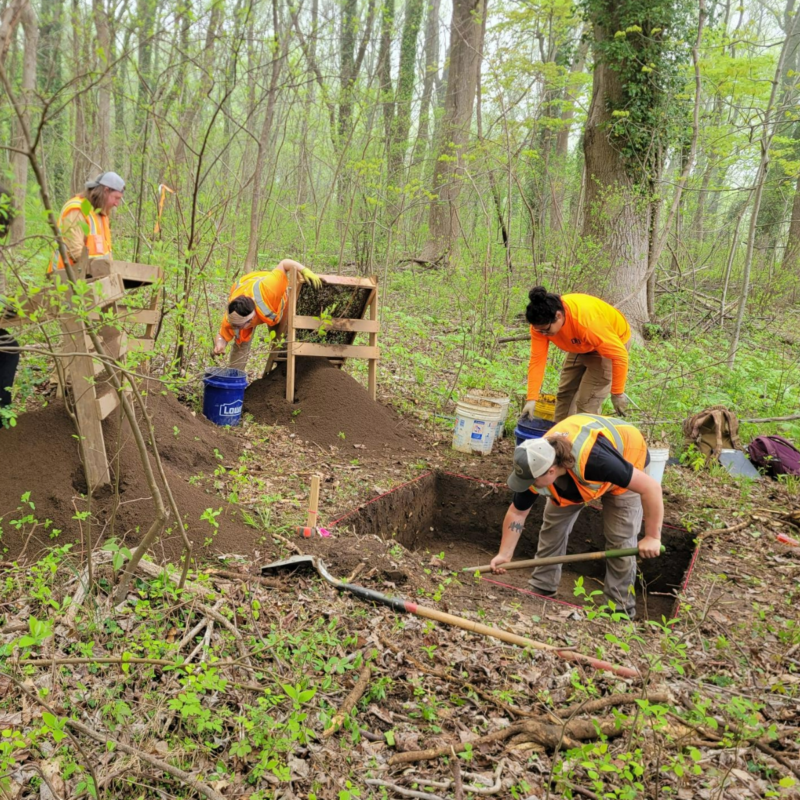 From beneath the forest floor near Chesapeake Beach, archaeologists have uncovered a 17th-century mystery: remnants of a site long forgotten that may hold new clues about life in early colonial Maryland.
From beneath the forest floor near Chesapeake Beach, archaeologists have uncovered a 17th-century mystery: remnants of a site long forgotten that may hold new clues about life in early colonial Maryland.
This rare discovery, made during a recent dig, reveals that history is often right under our feet – and with coastal erosion threatening sites like this, the need to preserve our shared heritage has never been more urgent.
A weeklong archaeology dig conducted in April this year revealed brick fragments, tobacco pipe stems and soil discolorations that indicate human activity. The site’s uniqueness lies in its apparent short period of use, which provides archaeologists with a snapshot of a specific moment in the region’s past. Artifacts recovered from the site place its occupation between approximately 1660 and 1715.
“What we have is a rare opportunity to examine a slice of time without the clutter of later periods,” said Christopher Sperling, historic planner for Department of Planning & Zoning. “It’s exciting for those who seek to know more about the early colonial history of Calvert County, but also has broader implications for archaeological study of the same period in other locations.”
The archaeological investigation was made possible through a Certified Local Government project grant from the National Park Service, administered by the Maryland Historical Trust. These competitive grants underscore the significance of this archaeological discovery. Following standard procurement procedures, the county selected Applied Archaeology and History Associates, Inc., to conduct the excavation.
For a firsthand look at the initial discoveries, viewers can watch a short documentary about the excavation at www.CalvertCountyMd.gov/UnearthingHistory.
Preserving the Mystery : While excavations are beginning to reveal details about the people who lived there, much remains unknown about the site’s purpose and inhabitants. The site’s discovery was accidental; fossil hunters stumbled upon artifacts and reported their findings, leading archaeologists to investigate further. Unlike other historic sites in the county, no known maps or documentation exist for the site, deepening the uncertainty surrounding its purpose and inhabitants. This lack of historical records makes physical evidence even more crucial in piecing together the story.
“The wonder of archaeology is the mystery,” said Sperling. “We’re essentially trying to reconstruct a puzzle without knowing how many pieces there are, or what the final picture should look like.”
To safeguard the site’s integrity, its exact location remains confidential. Archaeologists want to remind people that while it’s exciting to find something from the past, it’s important to leave potential artifacts undisturbed.
“Taking objects from a site can damage the context that helps piece together the broader story,” says Sperling. “Taking photos and reporting any finds to local authorities is always the best course of action.”
The Race Against Time and Tide : This discovery comes at a critical time for archaeology in Calvert County. Coastal erosion poses an imminent threat to historic sites along the bay and its tributaries. The investment in archaeological projects like this one is crucial to understanding how people lived, interacted and adapted to life in the Chesapeake region. These projects help piece together the complex history of the area, from Native Americans to early European settlers and African Americans – both free and enslaved – who shaped the region’s development.
While Calvert County may be better known for its fossil-heavy Calvert Cliffs, Calvert County’s rich human history, including Native American settlements and early colonial towns like Calverton, makes it an important area for archaeological exploration.
The study of fossils, or paleontology, focuses on understanding prehistoric life like plants, animals and ecosystems, but archaeology studies human history through excavating and studying artifacts, structures and other physical remains. Archaeologists piece together stories from the past by examining objects like pottery, tools and even soil patterns to help understand how people shaped the world we live in today.
“The investment in archaeological projects is important because it helps us identify, document and protect places that are important to our local history,” Sperling explained. “But from a wider perspective, it’s crucial for our understanding of how early settlers adapted to life in the Chesapeake region.”
As coastal erosion continues to threaten vulnerable historical sites, Calvert County remains committed to ensuring that these important pieces of history aren’t lost. Excavation work continues at Calverton, once the county’s first designated town, which was laid out on the shore of Battle Creek in the 17th century and built on the site of an earlier Native American settlement. Calverton is considered one of the most historically significant sites in the county. The archaeological work done there enhances researchers’ understanding of Maryland and American history and enables the county to mitigate its imminent loss to water and weather.
A More Complete Picture of the Past : Calvert County’s historic preservation initiatives contribute to a more comprehensive understanding of the area’s history and the diverse communities that shaped the region.
One such initiative is the ongoing historical preservation project focusing on African American soldiers who served in the United States Colored Troops during the Civil War. This project, a collaboration between the Department of Planning & Zoning and the Calvert Historical Society, aims to create a comprehensive database of Calvert County’s African American Civil War soldiers.
“History is vital because it helps us understand who we are today,” said Planning & Zoning Director Mary Beth Cook. “These projects offer a voice to people whose stories haven’t been written down. They help us appreciate the people who shaped Calvert County’s culture and society, to understand their legacy, and inspire us to become better stewards of our community for future generations.”
For those interested in learning more about preserving our shared heritage, please contact the Calvert County Department of Planning & Zoning or visit www.CalvertCountyMd.gov/HistoricPreservation.



